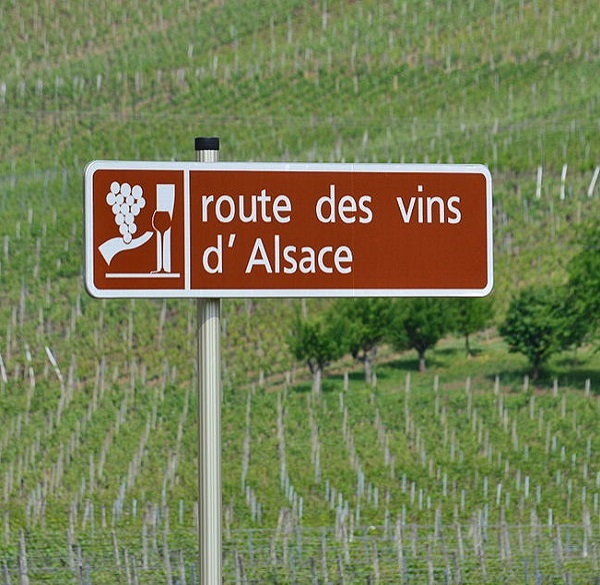Wine Region Alsace
Alsatian Wine
Vin d'Alsace / Weinbau in Elsass
Wines from Alsace are primarily white wines.
The Rhine region in Alsace and Germany are known to produce the best Rieslings in the world.
Alsace is also famous for its highly aromatic Gewürztraminer and a very food friendly Pinot Gris.
Riesling d'Alsace
In Alsace, some grapes thrive better than others, and just like in Germany (on the other side of the border), the king is Riesling.
Typical Alsatian Rieslings are dry, aromatic, a little fuller, and with more ripe fruit than the German ones.
Gewürztraminer d'Alsace
Gewürztraminer is a grape many people love. It is also a grape many people hate.
Bad Gewürztraminer can taste like bad perfume, but the good ones have fantastic aromas that no other grapes can copy: Grapefruit, Pineapple, Mango, Apricot, Lychee, Rose Petals, and Spices.
Pinot Gris d'Alsace
Italian Pinot Grigio and Alsatian Pinot Gris is the same grape, but Alsatian wines are more fruity, with more aromas, and more sweetness.
Alsatian Pinot Gris has a balanced intensity that pairs well with many types of food. It matches spicy food (Mexican, Thai), sweet and sour food (Chinese), and fat food(Foie Gras. Pâté), and often it can accompany dishes meant for red wine.
Silvaner d'Alsace
Silvaner (or Sylvaner) is a grape grown primarily in French Alsace and in the Franken region of Germany.
In Germany it is cultivated with the official name Grüner Silvaner. Italian and Swiss Silvaner tends to be lighter and more crispy than French / German Silvaner.
Pinot Blanc d’Alsace
Pinot Blanc from Alsace, is known to be much like Chardonnay as a full body wine with good acidity.
Alsacian Pinot Blanc can show a range of flavors from apple to peach, along with nutty almond and spices depending on oak treatment.
Popular food pairings in Alsace are Omelet and Quiche.
Crémant d’Alsace
Crémant d 'Alsace is a sparkling wine made by the Champagne method (Méthode Champenoise)). Made from several types of grapes (Chardonnay, Pinot Blanc, and Riesling), it can be an interesting alternative to French Champagne.
Tokay d'Alsace
According to the history, the grape Pinot Gris travelled from Alsace to Hungary in the 14th century. When it was brought back to Alsace in the 16th century, it was planted in Kientzheim under the name "Tokay" (taken from Hungary’s famous wine Tokaji).
For many centuries, Alsatian wine produced from Pinot Gris was called "Tokay d'Alsace".
However, in the 1990's, it was agreed in Europe to remove the name Tokay from non-Hungarian wine, and slowly, the today so famous Alsacian Pinot Gris was developed.
Alsace AOC
Alsatian wines are produced under three different AOCs:
- Alsace AOC - White, Rosé, and Red wines
- Alsace Grand Cru AOC - White wines from classified vineyards
- Crémant d'Alsace AOC - Sparkling wines
Edelzwicker
Edelzwicker may be used on an Alsatian wine label.
Edelzwicker means that the wine is a mixture of different grapes.
In practice, Edelzwicker is any blend of white grape varieties from the AOC Alsace, without indication of percentage.
Gentil
Gentil may be used on an Alsatian wine label.
Gentil can only be used for AOC wines where the blend has at least 50% Riesling, Muscat, Pinot Gris or Gewurztraminer, and the rest can be either Sylvaner, Chasselas or Pinot Blanc. Each variety must be vinified separately, and each variety must qualify as an AOC Alsace wine alone.
Vendange Tardive
Vendange Tardive on the label, means that the grapes are harvested late. These wines are sweet like German Ausleese. Only noble root attacked grapes can be used (Riesling, Muscat, Pinot Gris, and Gewurztraminer), and Gewurztraminer and Pinot Gris provide the sweetest varieties.
Sélection de Grains Nobles
Sélection de grains nobles means selected grapes that are attacked by noble rot, like German Beerenauslese.
Route des Vins d'Alsace
In the 1950's the Alsace Wine Route was opened.
Starting as a popular touring rally, it is now the jewel of Alsace.
Route des Vins d'Alsace winds 170 km from the north to the south of Alsace, passing through 70 wine-growing villages, some renowned for being some of the most beautiful villages in the world. like Eguisheim, Kaysersberg, Ribeauvillé, Riquewihr, Andlau, and Obernai.

The Alsace Wine Route villages organise wine and harvest festivals from April to October, including wine-tastings, folklore, processions, and other entertainment.
Alsace Wine Production in Hectares
Alsace is dominated by white wine. 90% of all Alsace wine is white.
The most famous sparkling wine is Crémant de Alsace
| Grape | 1969 | 2017 |
|---|---|---|
| 1. Riesling | 1200 | 3350 |
| 2. Pinot Blanc | 1040 | 3320 |
| 3. Gewürztraminer | 1950 | 3150 |
| 4. Pinot Gris | 390 | 2460 |
| 5. Pinot Noir | 200 | 1670 |
| 6. Sylvaner | 2580 | 920 |
| 7. Muscat | 340 | 350 |
| 8. Chardonnay | 0 | 200 |
| 9. Chasselas | 1000 | 70 |
| Total | 9440 | 15600 |
Source: Conseil Interprofessional Vins d’Alsace.


